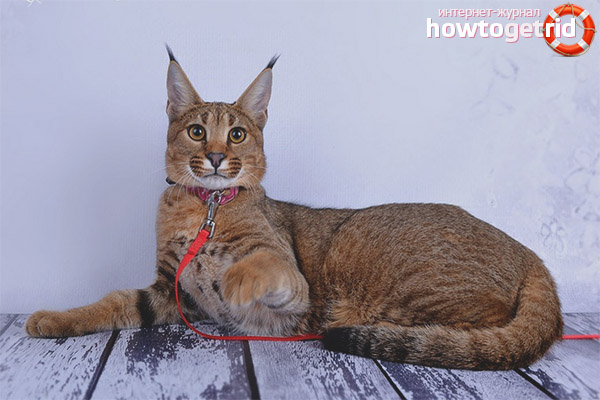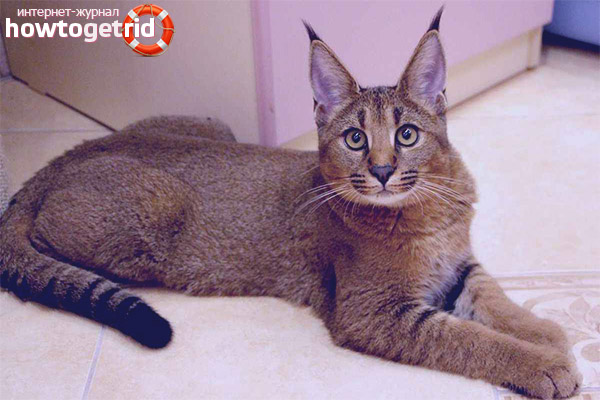The content of the article
The Caracat breed was bred by mixing a wild Caracal and a domesticated Bengal cat. An amazing hybrid that combines the best qualities from its parents, it combines brutality and a calm disposition.
The appearance of this rarest breed occurred not so long ago, its representatives are very appreciated by lovers of everything exotic. Not everyone can become the owner of such an animal, because a kitten is very expensive, the calculation is carried out in millions of rubles.
A bit of history
For the first time, hybrid kittens from a wild cat and a domestic cat began to be mentioned in the 80s of the previous century, when a stray cat got into a cage to a male caracal, which happened at the Moscow Zoo. As a result of this, a kitten was born whose appearance was more like a lynx, and its behavior was a simple domestic cat. Further breeding was not possible, since it was a hybrid male, and such animals can not have offspring up to the fifth generation.
Once again, breeders from the USA and Germany made an attempt to cross the male caracal with a domesticated cat 10 years later, but again the attempts failed.
Later, Russian breeder Irina Nazarova tried her luck, the merit of which was the development of hybrids until 2016 that inherited the appearance of a wild beast from their ancestors, but characterized by good temper and the ability to train. The breed was given the name "Caracat".
Breed description
Representatives of the breed have a catchy unusual appearance. A lot of it from the wild caracal, for example, a kind of brush on the ends of the ears.
- The size of these cats is slightly smaller than wild relatives, however, if they are well looked after and properly fed, their weight can reach 15 kilograms. Body length can reach 90 centimeters, height - 45 centimeters.
- The body of the caraquets is powerful muscular, legs are thin and long. On the abdominal region is a fold of fat, which also got them from the caracals. So in the wild, organs were protected from damage that the animal could receive by entering into a fight.
- Compared to the body, the cat’s head is small, slightly elongated, wedge-shaped. Eyes are green-yellow, almond-shaped, large, expressive.
- The color of the coat’s hair remained the same as that of its wild progenitor. Coloring can be various shades of brown: from pale sand to almost black. Moreover, the bottom of the neck, the abdominal and inguinal region are much lighter all the time.
- The muzzle and legs are decorated with contrasting stripes of dark color. In kittens on the fur, light spots are observed, which after a while disappear.
While observing several generations, representatives of this breed can experience incredible surprise at how their appearance changes. Babies born in the first generation are equally carriers of the genes of a domestic cat and a wild cat.
With each next generation, hybrids will take on a more domesticated appearance and complaisant disposition, while maintaining the color of the hair of the caracal and the brush on the ears.
Character
Such cats are distinguished by an independent and independent character. They are obedient, affectionate, but not intrusive. They have a lot of energy, they like to move and play.
Representatives of this breed are excellent hunters, because their ancestors were large predatory animals. Most owners notice that cats are incredibly jumping. Jumping to a height of three meters is not a problem for them.Caraquets have a well-developed hearing, they are able to hear a quiet rustling at a distance of several tens of meters.
Such cats are very smart. They get used to their name in a short time and begin to respond to it, can be trained, are able to remember simple tricks, strictly abide by the rules established in the family.
Although cats have a rather formidable appearance and impressive dimensions, keeping them in the house is not dangerous. They showed themselves as kind animals with a high level of intelligence. Although in some cases it is not without stubbornness and whims. But no need to worry about this, cats have such a temper.
In relation to other pets, carriages are not aggressive, but, on the contrary, show interest and call them into their fun activities.
Content Features
The maintenance of representatives of this breed in an apartment is not advisable. The blood of a wild animal that flows in their veins makes itself felt. Such cats prefer large spaces, like to move freely. The best solution would be a country house where the animal can walk for walks on its own.
- To begin with, it is recommended not to allow the pet to move around the house. You should give him a small room where the tray will be located, a plate with food and water, a games area, a scratching post and a comfortable bed. In this way, the pet will more quickly get used to the new situation, unfamiliar smells, and newly-made owners.
- Little caraquets often hiss, but you don’t need to worry about it, because only in this way can they show their strength and courage. It is better to protect the kitten from noise, sharp sounds, so that the baby does not experience stress.
- It is not difficult to take care of the pet's short hair, however, it is necessary to regularly comb out, especially when the animal molts.
- Bathing should be carried out no more than once every three months. As a rule, this does not cause trouble, because such cats are not afraid of water.
Nutrition and Health
Caraquets have a fairly well-developed and strong digestive system. They inherited this from wild ancestors, for whom the digestion of raw meat, bones and skins was normal.
The menu of your pet should include natural products. The diet should consist of raw lean meat (veal, beef, turkey). In addition, you need to feed him fish, give vitamins, especially to young cats.
Since karakety are large enough animals, they eat about twice as much as ordinary cats. It is necessary that the amount of feed per day is 5-10 percent of the body weight of the pet.
Representing a descendant of a wild cat, the caracat has good health and strong immunity. Over the years of breeding, not a single case of infection of the animal was found in the most common diseases in cats.
There is no need to speak about diseases of a genetic nature at the moment, since very little time has passed since the beginning of the formation of the breed.
Cost, where to buy
If you know how difficult it is to breed this exotic breed, there is no surprise that kittens are quite expensive, very few people can afford it.
Also, the cost is affected by the fact that the breed is relatively new, so there are still a few individuals.
A kitten on average can cost from one to one and a half million rubles, while the owner will not have the right to breed him in the future.
Video: Caracat and an ordinary cat












Submit